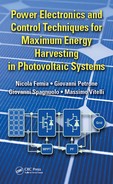Contents
1.1 From the Photovoltaic Cell to the Field
1.2 The Electrical Characteristic of a PV Module
1.3 The Double-Diode and Single-Diode Models
1.4 From Data Sheet Values to Model Parameters
1.4.1 Parameters Identification Assuming Rp → ∞
1.4.2 Parameters Identification Including Rp
1.4.3 Parameters Identification Including Rp: Explicit Solution
1.4.4 Other Approaches Proposed in Literature
1.5 Example: PV Module Equivalent Circuit Parameters Calculation
1.6 The Lambert W Function for Modeling a PV Field
1.6.1 PV Generator Working in Uniform Conditions
1.6.2 Modeling a Mismatched PV Generator
2 Maximum Power Point Tracking
2.1 The Dynamic Optimization Problem
2.2 Fractional Open-Circuit Voltage and Short-Circuit Current
2.4 The Perturb and Observe Approach
2.4.1 Performance Optimization: Steady-State and Dynamic Conditions
2.4.2 Rapidly Changing Irradiance Conditions
2.4.3 P&O Design Example: A PV Battery Charger
2.5 Improvements of the P&O Algorithm
2.5.1 P&O with Adaptive Step Size
2.5.2 P&O with Parabolic Approximation
2.6 Evolution of the Perturbative Method
2.6.1 Particle Swarm Optimization (PSO)
2.6.2 Extremum Seeking and Ripple Correlation Techniques
2.6.3 The Incremental Conductance Method
2.7 PV MPPT via Output Parameters
3 MPPT Efficiency: Noise Sources and Methods for Reducing Their Effects
3.1 Low-Frequency Disturbances in Single-Phase Applications
3.1.1 The Perturb and Observe Approach Applied to Closed-Loop Switching Converters
3.1.2 Example of P&O Design for a Closed-Loop Boost Converter
3.2 Instability of the Current-Based MPPT Algorithms
3.3.1 Noise Rejection by Sliding Mode: Numerical Example
3.3.2 MPPT Current Control by Sliding Mode
3.3.2.1 Basic Configuration of Sliding Mode with Voltage Controller
3.3.2.2 Voltage Controller Design
3.3.3 Sliding Mode MPPT Controller: Numerical Example
3.4 Analysis of the MPPT Performances in a Noisy Environment
3.4.1 Noise Attenuation by Using Low-Pass Filters
3.4.2 Error Compensation by Increasing the Step Perturbation
3.4.3 ADC Quantization Error in the P&O Algorithm: Numerical Example
4 Distributed Maximum Power Point Tracking of Photovoltaic Arrays
4.1 Limitations of Standard MPPT
4.2 A New Approach: Distributed MPPT
4.2.1 DMPPT by Means of Microinverters
4.2.2 DMPPT by Means of DC/DC Converters
4.3 DC Analysis of a PV Array with DMPPT
4.3.1 Feasible Operating Regions
4.3.2 Examples of Feasible Operating Regions
4.3.3 I-V and P-V Characteristics of Boost-Based SCPVMs
4.3.4 I-V and P-V Characteristics of Buckboost-Based SCPVMs
4.4 Optimal Operating Range of the DC Inverter Input Voltage
4.5 AC Analysis of a PV Array with DMPPT
4.5.1 AC Model of a Single SCPVM
4.5.2 Small-Signal Model of a Photovoltaic Array with DMPPT
4.5.3 Stability of a String of SCPVMs
5 Design of High-Energy-Efficiency Power Converters for PV MPPT Applications
5.3 Energy Harvesting in PV Plant Using DMPPT Power Converters
5.4 Losses in Power Converters
